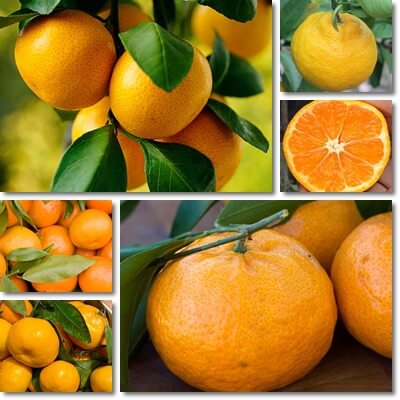Satsuma orange or satsuma mandarin, also called simply satsuma, is a cross between the mandarin and the pomelo. The citrus fruit is bright orange, seedless and easy to peel, with a pleasant sweet taste and low acidity. Satsuma oranges boast a good content of vitamin C, but otherwise have modest nutrition. Eating satsuma helps keep skin young and teeth and gums healthy. The citrus fruit is good to eat in pregnancy and has anti-inflammatory and blood pressure lowering benefits.
Even diabetics can eat satsuma safely without risking spikes in blood sugar levels.
What is satsuma?
Botanically speaking, satsuma is a mandarin hybrid. More exactly, satsuma is a cross between a mandarin and a pomelo, but something along the lines of a mandarin that was not quite genetically pure to begin with, so a mandarin hybrid, that was crossed with a pomelo or pomelo hybrid and the resulting citrus fruit was crossed back again with the same mandarin or mandarin hybrid. The scientific name for satsumas is Citrus unshiu.

It’s actually difficult to tell satsuma apart from all the different types of oranges, mandarins and orange or mandarin hybrids, not just because of how similar they may look and taste, but also because satsumas are often marketed as satsuma oranges, satsuma mandarin oranges, mandarins or seedless mandarins. The purely commercial choice of names is a source of confusion. Other common names include unshu mikan, mikan, cold hardy mandarin and naartjie.
What does a satsuma orange look like?
Satsuma oranges are smaller than the common sweet orange, but larger than the mandarin, with a bright orange to red-orange, relatively thin, dimpled and leathery rind that is very easy to peel, but bruises easily. Satsumas are not perfectly round, but rather somewhat flattened at the poles, at times a little more irregular in places, and may look deflated when the rind is more loose-fitting. The flesh is juicy, bright orange and segmented, separated by a thin peel. Satsumas have very little white spongy pith and no seeds which is also why they are often called seedless mandarins.
What does a satsuma orange taste like?
Ripe satsumas have sweet mandarin-like flavors balanced out by a pleasant, but not excessive tartness. They are quite citrussy and fresh, with a strong odor. The flesh is extremely juicy and the separated into segments by a very thin peel which makes them excellent for eating fresh as well as juicing. Satsuma rind is great for uses such as flavoring baked goods and other desserts, making marmalade and tea.
Find your inspiration with these 5 healthy orange tea recipes.
When is satsuma season?
Satsuma season differs primarily according to region of cultivation and the climate of the region of cultivation. Satsuma oranges are in season early fall through winter, that is, late October (at the earliest) to late January, early February (at the latest). Peak season for satsumas is late November through December.

Satsuma nutrition facts
Despite the fact that they are often called satsuma oranges, or satsuma mandarin oranges, botanically speaking, satsumas are mostly mandarins. Which means that the nutrition of the satsuma is, for the most part, the nutrition of the mandarin. Satsumas have a good content of vitamin C: around 30% of the recommended daily intake (RDI) of vitamin C for an average adult per 100 g of fruit.
Other notable essential vitamins and minerals in satsuma oranges include: vitamin B6 (6% of RDI, recommended daily intake), vitamin B1 (5%), vitamins B5, B9 and A, calcium and potassium (4%), vitamins B2, B3, magnesium and phosphorus (3%). The citrus fruit is almost sodium-free and contains trace amounts of vitamin E, manganese, iron and zinc. Satsumas have over 50 kcal per 100 g and over 13 g of carbs, of which about 10.5 g natural sugars and 1.8 g dietary fiber.
What are the benefits of satsuma oranges?
Help keep skin young
Satsuma oranges provide 30% of the daily recommended intake of vitamin C for every 100 g. Vitamin C stimulates the production of collagen in the skin which helps maintain skin elasticity and prevent premature wrinkles for more youthful looking skin.
Good for healthy teeth and gums
Getting enough vitamin C in your diet is essential for healthy teeth and gums and satsuma oranges are a good food option to help you get your daily vitamin C. Vitamin C helps grow and repair connective tissue in the gums by synthesizing collagen and actively regenerating tissue, as well as exerting an anti-inflammatory action. Vitamin C also combats gum bleeding by strengthening capillary walls – capillaries are the tiny blood vessels that feed tissues in the body, keeping the alive. Healthy gums support teeth health and prevent tooth loss.
Help lower blood pressure numbers
Eating satsumas or drinking satsuma juice is good for high blood pressure. The fruit and juice contain potassium and magnesium with blood pressure lowering benefits, and are also almost sodium-free. Satsuma juice is especially good for high blood pressure because it has a higher content of potassium and magnesium compared to the whole fruit.
Good for high cholesterol
Studies show hesperidin in satsuma oranges and citrus fruit in general has cholesterol-lowering properties (source). Hesperidin is found in the spongy white pith or albedo of citrus fruit, as well as juice. Vitamin C is a source of additional cardiovascular benefits, helping keep arteries clean of plaque and contributing to anti-atherosclerotic benefits.
Minor benefits for anemia
The citrus fruit and juice do not have any vitamin B12 and only small amounts of other B vitamins needed to combat anemia. However, both satsuma oranges and satsuma juice are good for anemia because they provide generous amounts of vitamin C which boosts absorption of iron from other foods.
Good for pregnant women
Satsuma oranges and satsuma juice provide small amounts of potassium and magnesium with benefits for pregnancy-associated high blood pressure and small amounts of B vitamins (with the exception of vitamin B12) which help produce red blood cells and their components and support the expanding circulatory system of the pregnant woman.
Vitamin B9 in satsumas help prevent defects of the brain, spine and spinal cord in babies during pregnancy, while the generous vitamin C content boosts absorption of iron for anti-anemia effects, helping combat tiredness and fatigue associated with pregnancy.
Anticancer food
Satsuma oranges contain biologically active anticancer components such as vitamin C, hesperidin and other antioxidants with anti-inflammatory, anti-mutagenic and immune system modulating effects. According to studies, vitamin C targets many of the mechanisms that cancer cells utilize for their survival and growth (source). Hesperidin has strong anti-oxidant and anti-inflammatory activities, induces apoptosis and cell cycle arrest, inhibits tumor cell metastasis, angiogenesis, and chemoresistance (source).
Anti-inflammatory food
Vitamin C and antioxidant flavonones such as hesperidin found in satsuma oranges have scientifically proven anti-inflammatory properties. Vitamin C is shown to lower levels of several inflammation markers (e.g. C-reactive protein), and help reduce inflammation in the body. The flavonone hesperidin has been shown to also exert anti-inflammatory effects (source). Hesperidin is found in the spongy white part of citrus fruit, also known as albedo or pith, as well as juice and even rind.
Antibacterial, antiviral, antifungal properties
Vitamin C in satsumas has antibacterial, antiviral and antifungal properties. Antioxidants such as naringenin and other flavanones and bioactive compounds in satsuma flesh, juice and pith also exert antibacterial, antiviral and antifungal effects. Satsuma peel is a source of aromatic volatile organic compounds with an antimicrobial and antifungal action.
Good to eat in diabetes
Satsuma oranges are a good and safe food to eat for diabetics in the sense that they are a low GI food with a glycemic index score of around 40. What this means is the reasonable intakes do not cause spikes in blood sugar levels in diabetics. Satsumas will, however, raise blood sugar which is why it’s important to keep to small intakes.
Tonic, restorative food
Satsumas are high in water and help combat dehydration and loss of fluids as a result of vomiting or diarrhea. The natural sugars in the fruit raise blood sugar levels for quick energy. B vitamins and dietary minerals in the citrus fruit have a tonic, restorative action.
Minor laxative properties
Getting enough fruit and vegetables in your diet helps combat constipation naturally. Eating satsumas provides dietary fiber which helps regulate transit time and promotes easy and regular bowel movements.
Good food to eat for nausea
Satsuma is a good food to eat for nausea because it’s just the right combination of sweet and sour and can be very refreshing, without further inducing nausea. Vitamin C along with the naturally occurring organic acids in the citrus fruit also actively combat nausea and help restore appetite, albeit temporarily.
Good food to eat for hypoglycemia
Hypoglycemia is a state of abnormally low blood sugar levels that results in symptoms such as lightheadedness, dizziness, muscle weakness and generalized weakness accompanied by a fainting sensation, but also irritability, palpitations or cold sweats. Eating a couple of satsuma oranges can bring blood sugar levels back to normal almost instantly and restore good mood and energy levels.
Helps you lose weight
Satsumas are low in calories (only about 50 kcal/100 g) and very low in fat (about 0.3% fat), but a source of essential vitamins, minerals, anti-inflammatory and antioxidant components that promote good health and can make a great food to add to your diet if you are looking to lose some weight.
What are the side effects of satsuma oranges?
Satsuma oranges are generally safe to eat and do no carry any contraindications when consumed in normal food amounts. While side effects are possible, these tend to be very rare and/or minor, usually self-resolving, primarily associated with excessive intakes. Some people may experience teeth sensitivity after eating satsumas or drinking satsuma juice because of the organic acids present naturally in the fruit and its juice. Those with acid reflux disease (GERD), gastritis or a stomach ulcer may experience digestive upset after eating satsumas or drinking satsuma juice, but this is not true for everyone. In rare cases, allergic reactions may occur.
